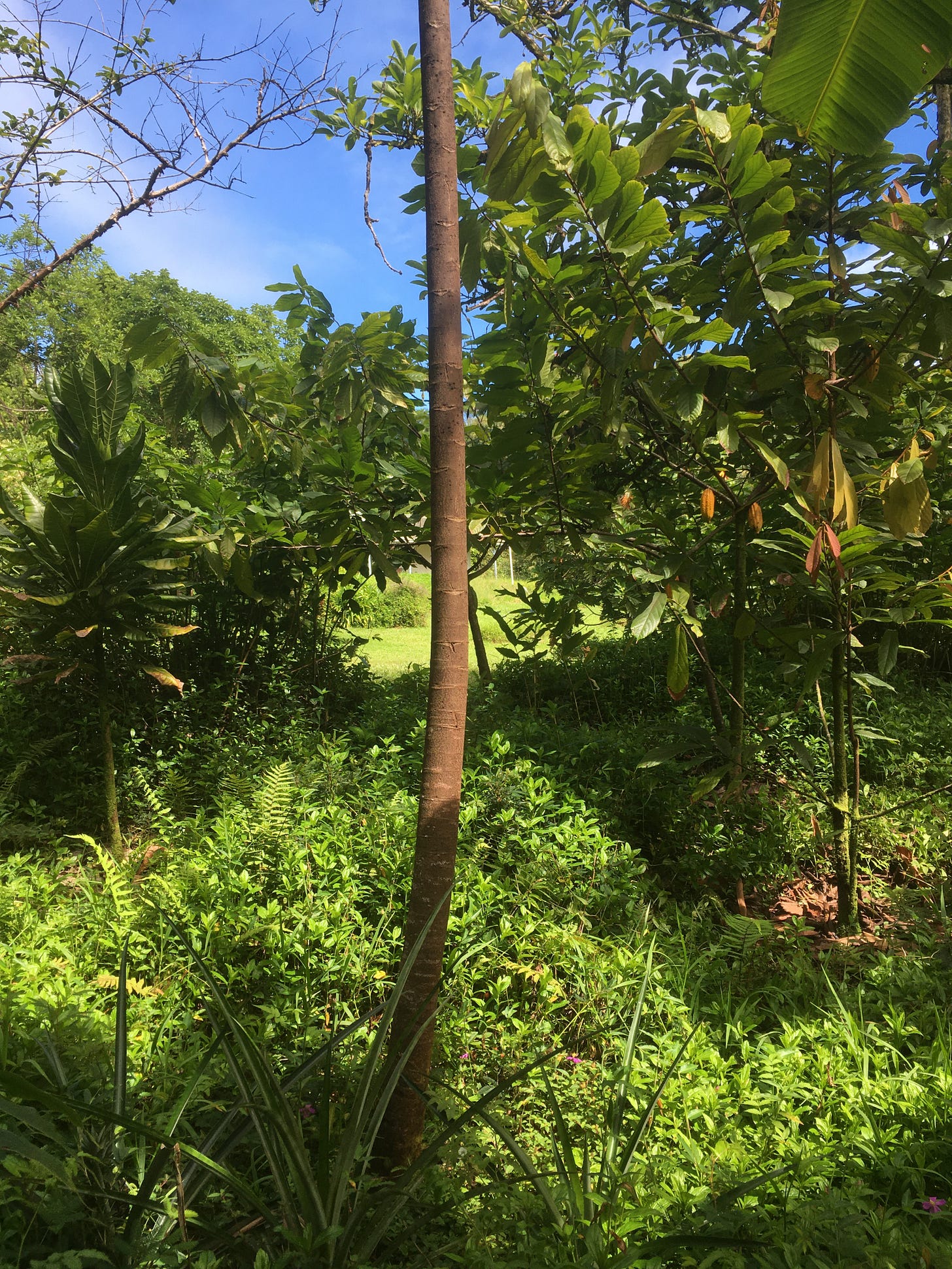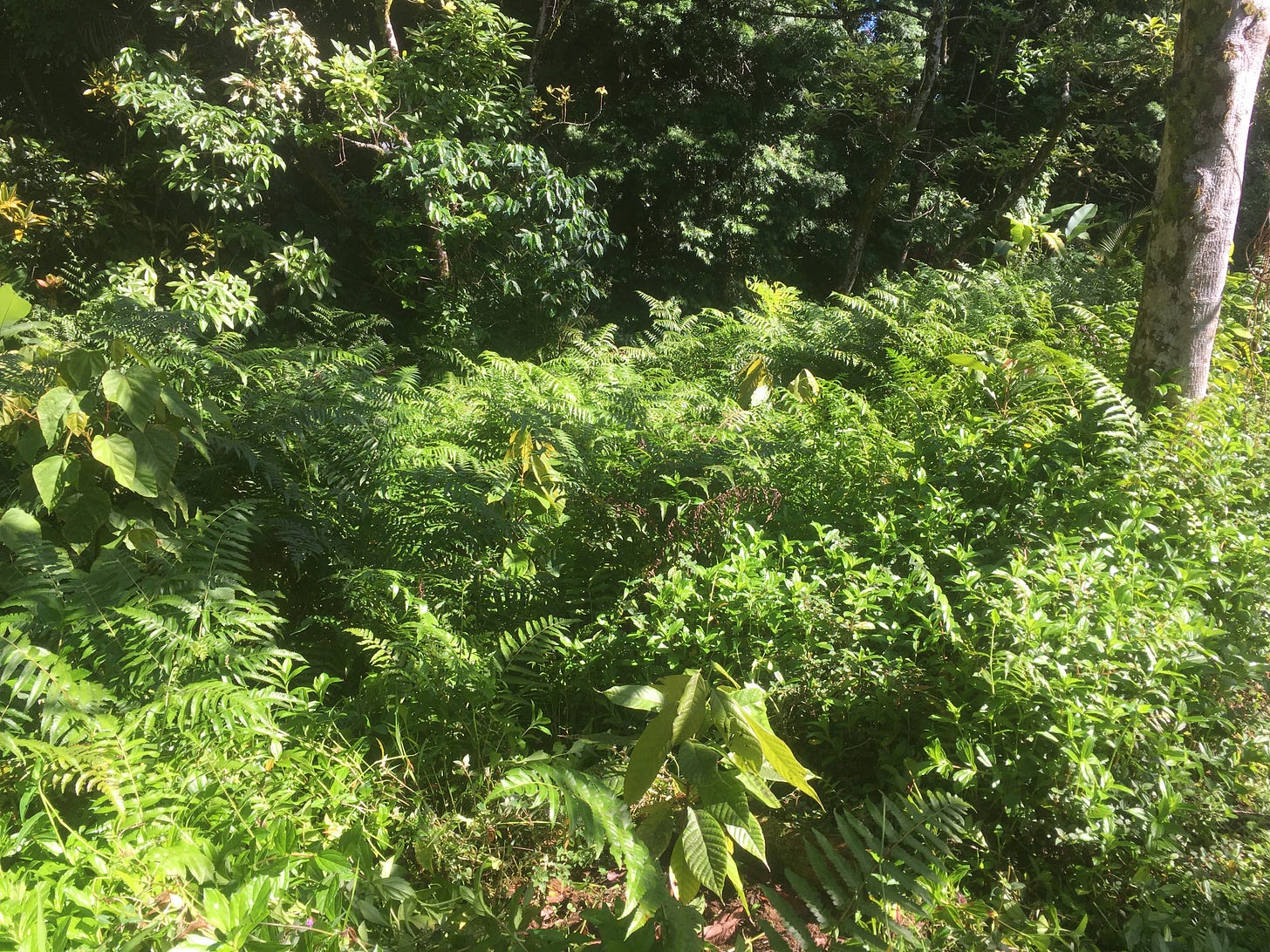The college students who attended my cacao processing and chocolate tasting class last weekend asked astute questions, including some about the sustainability of growing cacao. I answered that sustainability of cacao orchards depends on the farming practices. The people of Mesoamerica grew, and often still grow, cacao in milpa systems, which include plant communities of many plant species. If a more sustainable way of farming exists, I’m not sure what that would be.

We grow cacao in much simpler food forests than the Mayan milpa, but we take much inspiration from them. Before I describe what we call the “cacao groves,” I should clarify that we are still experimenting and figuring it out. I am eager to hear suggestions and reports about what is working for other people. Since I had trouble finding examples when we first started, I thought photos of our plants may be helpful to those starting out. Part of the reason for a dearth of examples online may be the difficulty in communicating food forests through photos. They often just look like walls of green. But, I’ve attempted to take photos from perspectives that allow some clarity.
For the record, we have about 3 acres of gently sloping land on the Hāmākua coast, windward Hawai'i Island, at an elevation of about 250 feet. We are blessed with lots of rain, usually pleasant trade winds, and deep, acidic soil of varying quality.
Some of the reasons we decided to not monocrop:
My first exposure to cacao farming was a milpa-style orchard in Belize, so that example has become my OG of sorts.
While food forests, permaculture, and agroforestry are hip and trendy (and therefore suspect), the concepts behind them are ancient with merit as more environmentally friendly alternatives to modern agriculture.
Studies show that cacao grown in agroforestry environments may not yield as much per acre, but the total output when counting all of the crops can be greater than monocrop orchards, and with less labor required.
I’ve heard many stories of farmers noticing that the flavor of their cacao is influenced by the plants growing nearby. How this happens is unknown. Perhaps communication through the soil? In any case, I wanted to create the possibilities complex flavors through inter-species interactions. (And, honestly although slightly embarrassingly, want to give the trees the best opportunity I can to have full, happy lives.)
Since we are not planning to have a commercial operation and need to be concerned primarily with yield, we can do whatever we want. ;) I like the feeling of walking into a jungle when I care for the cacao trees in our yard.
We love cacao, but we love other plants, too. Diverse planting helps us grow more of our food. Also, some of the plant neighbors, like nuts, fruits, and spices, will provide delicious and nutritious inclusions our home-grown chocolate!
As an understory tree with a tap root, cacao is a valuable member of an ecosystem. We grow taller trees, like avocado, spice trees, coconut, and jaguar cacao as the canopy; other small trees and shrubs like banana, gingers including turmeric and cardamom, heliconia, annatto, tea, coffee, and berries; a few vines like vanilla, black peppercorn, liliko'i, and sacha inchi; and keep a layer of short plants, most of which are currently weeds, but some are edible or medicinal, including hō'i'o fern, mimosa, self-heal, gotu kola, pineapple, and thimble berry. You may spot a few orchids or nepenthes hanging out for fun and color. My vision is to gradually replace the wild weeds (wedelia, honohono, Spanish shawl, and others) with intentional ground covers as the trees grow and create more shade. We endeavor to keep the ground covered, weeding and mulching the areas around the trees.
We have seven cacao groves, each with five to ten cacao trees. Each has a different personality based on the micro-environment and the mixture of plants.

To be honest, I suspect our cacao trees are growing more slowly than they would in a monocrop orchard. Part of the difference may be that we don’t give them outside fertilizer, except occasional chicken manure. In the future I will put more effort into feeding the trees through mulching. Despite the slower growth, I feel patient because I am attached to this idea of plant communities. Working in the cacao groves always puts a smile on my face.
A huge advantage to this system is the protection provided by the weeds to the young cacao. While farmers in our area usually need to employ barrier screens to keep Chinese rose beetles away from the leaves of young trees, the weeds (mostly) keep our seedlings safe.
Who else is growing cacao in communities? What plants have you found to be good neighbors?





